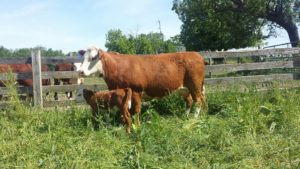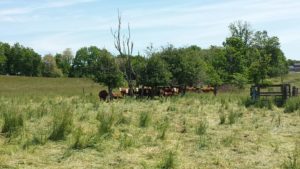By Shannon Traphagen
As someone who does not eat a lot of red meat, I gained an extensive education about the health benefits of red meat–particularly beef.
The Rochester and Western NY Board of Directors of the American Heart Association (AHA) had its annual end of the year meeting. This year we decided to have a retreat, taking us out to Medina NY to SK Herefords Farm, owned by David Schubel, and Phil and Dawn Keppler. With an operation that consists of approximately 1200 acres of pasture and row crops, the farm holds approxim ately 300 female cows every spring and breeds over 300 cows during summer. The farm also carries bulls, and feeder cattle. The family handles all cattle with extreme care and treats them like part of the family. “Animal welfare is very important to us,” states Alana Keppler, daugther of Phil and Dawn.
ately 300 female cows every spring and breeds over 300 cows during summer. The farm also carries bulls, and feeder cattle. The family handles all cattle with extreme care and treats them like part of the family. “Animal welfare is very important to us,” states Alana Keppler, daugther of Phil and Dawn.
The day started with an introduction by Chan Phillips, Director of Nutrition and Education of the NY Beef Council. The Keppler family then gave a tour of the farm that included seeing how the cattle are cared for, what they eat throughout the year, and breeding practices. Herefords  Farm goes to great lengths to preserve and take care of the land. Various migrating bird populations could be seen nesting in the tall stalks of grass. “For us it’s about preserving the land for the next generation and the one after that. We do what we do because we care about the cattle, the land, and the type of product that’s being produced,” states Keppler.
Farm goes to great lengths to preserve and take care of the land. Various migrating bird populations could be seen nesting in the tall stalks of grass. “For us it’s about preserving the land for the next generation and the one after that. We do what we do because we care about the cattle, the land, and the type of product that’s being produced,” states Keppler.
After the tour, the Beef Council gave a presentation and taste test on two different types of beef–grain-finished and grass-finished. According to the Beef Council, grain-finished beef is the larger percentage of beef carried in U.S. markets today. It is quality graded and given Federal Drug Administration (FDA) approved antibiotics or growth hormones. Grass-finished, by comparison, is cattle that consumes grass for their lifetime. These cattle are never fed grain, and usually produce a leaner meat that is sent to small local produce markets and processors.
What was interesting to learn is that both types of beef provide the same essential nutrients, with the exception of omega-3s, which are slightly higher in the grass-finished cattle. However, both offer half of the necessary heart-healthy mono-unsaturated fat that is commonly found in olive oils. According to the AHA, a heart-healthy diet consisting of lean beef helps lower LDL (Low-Density Lipoprotein) cholesterol by ten percent.
The AHA and the NY Beef Council feel it’s important to educate consumers on the benefits of beef. “Many consumers are very concerned about farming practices, how cattle are handled, and what ends up on the shelves at the grocers,” states Phillips. According to the Beef Council, 76% of tour attendees no longer have concerns about cattle farming practices after a tour.
“It’s all about education, portion control and quantity,” says Phillips.
Visiting the farm was an eye-opener as to the benefits of eating beef. For me, it also reduced my concerns and anxiety over farming practices.
For information or to schedule a farm tour contact Chan Phillips at the NY Beef Council at cphillips@nybeef.org or call 315.339.6922. For upcoming American Heart Association events or information contact www.heart.org or call the WNY office at 716.243.4602.











